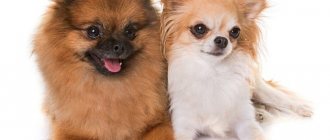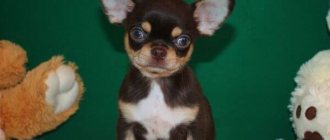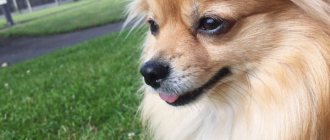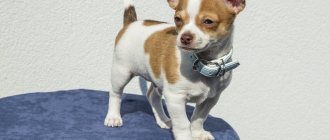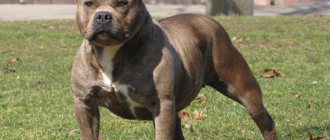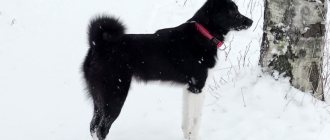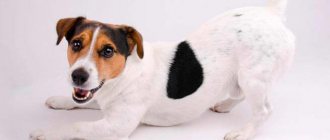Features of the Chihuahua breed, its feeding, care, health, pregnancy and vaccinations.
What colors and sizes are Chihuahua dogs? How many years do they live at home, to what age do they grow, when do Chihuahua dogs’ ears stand up, and when do their teeth change? At what age should a puppy be adopted, spayed, neutered, and what vaccinations should a Chihuahua puppy have? How many times a day and what food is best to feed a dog, how much should a Chihuahua dog eat at a time, and what weight should a Chihuahua dog weigh? How often and how many days does a Chihuahua dog's pregnancy last?
Adaptation and care of the puppy
So, what are the characteristics of a Chihuahua and how to care for this breed from the first days? Experienced owners can pick up a puppy when it turns 2 months old, but for beginners it is better to wait another month until the baby gets stronger. Read the parents' description carefully in advance.
Before you bring a Chihuahua puppy into your home, you should purchase a bed, litter tray, food and drink bowls, a brush and toys. But what needs to be removed from easily accessible places are dangerous things (wires, chemicals) and shoes. It is necessary to close the gaps under the furniture - if the baby climbs in there, he can hurt his back. Pay attention to the safety of the balcony.
Caring for a Chihuahua puppy begins with a demonstration of the sleeping pad. Then let him walk around calmly and get used to his new home. If there are other animals, watch the introductions carefully. Chihuahuas themselves are quite conflict-free and will not be the first to bully.
The first step in training should be teaching the puppy his name and the command “Come to me!” Use this combination every time you call him to eat. In the future, do not forget about training - the dog’s future behavior is laid down right now.
Dog education and training
Training a Chihuahua requires a special approach.
It's better to do it while playing. During it, the dog will understand what exactly is required of it. It is not necessary to undergo a professional training course .
IMPORTANT!
The most important thing is to teach the dog the rules of behavior in the house, on the street, at an exhibition and to develop his skills of cleanliness and obedience.
This should be done from the first day the Chihuahua appears in the house; it will be difficult to re-educate it.
Organization of a sleeping place
To properly maintain a Chihuahua, you need to provide it with a sleeping place. For relaxation, this dog prefers soft, warm beds or houses - these are sold in any pet store. You need to make sure the structure is strong. You need to lay a soft rug in the house.
When talking about how to care for a Chihuahua, we must not forget about the correct location of the sleeping area. It should not be in a draft, near household or heating appliances, or on a hill. Location next to the door is undesirable. In an apartment with a large area, you can put several places to relax at once.
Popular nicknames for boys and girls
When purchasing a dog, it is very important to choose the right name for it.
For boys:
- Maurice;
- Oscar;
- Jam;
- Max;
- Archie;
- Mickey;
- Casper;
- Pudding;
- Shustrik;
- Freddie.
For girls:
- Grace;
- Chloe;
- Doris;
- Dolly;
- Button;
- Bagheera;
- Snowball;
- Bead;
- Laura;
- Sarah.
Feeding a Chihuahua
To properly care for your Chihuahua at home, it is important to provide your pet with a balanced diet. In addition to specialized dog food, a Chihuahua's diet must contain fats and proteins - such as fish, cottage cheese and meat, as well as carbohydrates in moderation. But dishes from the human table are contraindicated for mini Chihuahuas. Especially dangerous foods: nuts, legumes, onions.
Fatty, salty, smoked and fried foods can cause great harm to health. If you want to pamper your pet with something tasty, it is better to buy a special treat for animals. The dog should eat 2-3 times a day. Chihuahuas are prone to overeating and obesity, so no matter how much they love and beg for treats, they should not be indulged.
What is the best food for a Chihuahua?
Undoubtedly, such dogs cannot be fed from the table. It is imperative to adhere to a strict diet:
- Porridge
- Boiled lean meat
- By-products
- Dairy
Preparing food for a dog takes time, so ready-made food is often used to save time.
List of the best food for Chihuahuas:
- NOW Natural Fresh Small Breed Recipe
- Grandorf 4 Meat & Brown Rice
- Almo Nature Holistic Adult Dog Small
- Purina Pro Plan Small & Mini Adult canine
- Bosch Mini Adult
Cute little dog
How to train to the tray
Caring for Chihuahuas is also simplified by the fact that they can go to the tray, so there is no need to walk them in any weather. To train your puppy to use the litter box, at first carefully observe his behavior after eating or sleeping. When he starts to worry and look for a secluded place, he needs to be put in a tray. Praise your puppy when he gets it right, especially if he starts going to the litter box on his own initiative. You need to scold your child immediately if he goes to the toilet in the wrong place, otherwise he won’t even understand what’s going on.
Advantages and disadvantages
Advantages:
- This is a compact breed that will fit not only in a small apartment, but also in a woman’s bag;
- If necessary, walks can be reduced to a minimum, or a couple of times completely abandoned - the dog can easily go to the tray;
- Devoted and faithful to the owner;
- Good health;
- You can take such a dog to a cafe or pharmacy when it sits quietly in your purse;
- Easy care.
Flaws:
- The breed absolutely does not tolerate cold; in winter and autumn it will need special clothing;
- Does not get along well with other pets;
- They are prone to food allergies, therefore they are picky eaters;
- Fragile animals that need to be protected from falls and injuries;
- Fearlessness reaching the point of recklessness;
- They are jealous, touchy and do not tolerate loneliness well.
Each dog is individual, but if you notice traits in it that you don’t like, there is always a chance to re-educate it.
When training a Chihuahua, you need to be patient and persistent, without overstepping the line, so as not to offend the dog.
Grooming
When mapping out a plan for how to properly care for your Chihuahua, don’t forget about the coat. Chihuahua breeds can have long or short hair. Smooth-haired dogs should be brushed once or twice a week with a massage mitt or a medium-hard wooden comb. Long-haired cats require brushing every other day. You will need a pet comb with rounded ends or a wooden comb. During shedding, it is better to use a special slicker comb.
In hot weather, a dog with long hair can be trimmed, but for this you should contact a specialist, since it is very easy to spoil the appearance of the dog yourself.
Types of crossbreeds
The following crossbreeds of Chihuahuas exist with other breeds: Pinscher, Pekingese, Yorkshire Terrier, Pug, Dachshund, Pomeranian, Jack Russell Terrier and Toy Terrier.
Also read comparison of Toy Terrier and Chihuahua.
Bathing and cleaning ears, eyes, teeth
You need to bathe your Chihuahua about three times a year (excluding some emergency situations) using pet shampoo. Too private “bath days” will only spoil the hair, make it brittle and may cause dandruff. The care and maintenance of these dogs necessarily involves dental care. Once a week you need to brush them with a special paste, which will prevent the appearance of tartar (to which this dog is predisposed) and bad breath. Gnawing toys, which are available in pet stores, will also come in handy.
Pregnancy in a Chihuahua: symptoms
You should not expect your dog to show any symptoms of pregnancy immediately after mating. Usually the first signs can be seen no earlier than after 20-25 days. There are no tests for dogs like there are for people, so pregnancy can only be determined by a doctor, but also after 20 days. It is this period that is the turning point when it is already possible to determine and diagnose pregnancy by palpation.
Symptoms of pregnancy in Chihuahuas:
- However, pet owners may observe changes in the girl's behavior. They are usually observed starting 14 days after conception. The dog’s behavior changes, it becomes calmer and more balanced, spends little time walking outside, and immediately goes home.
- She spends most of her free time in her bed and is not as playful as before. In the period after 20 days, the dog may experience toxicosis, therefore the appetite decreases.
- Do not insist on food, and feed your dog foods high in calcium. You can give special vitamins for dogs. The longer the pregnancy, the calmer the girl becomes. She is phlegmatic and practically does not react to stimuli. Doesn't walk much, may lick private parts.
- Pregnancy can also be determined by the nipples, as they swell. After 2 months, immediately before giving birth, the dog may experience mucous discharge from the vulva. This indicates that the mucous plug is coming out and the dog is ready to give birth.
Dog after birth
Walks in the open air
You need to remember: the characteristics of the breed make these dogs curious and brave, so you only need to walk with a Chihuahua on a leash in order to protect them in time from a fight with a dog or cat and other problems. For a Chihuahua, a harness is desirable (a double leash for the neck and body), but it can only be used for adult dogs; in a puppy, it can cause crooked paws. Before you take your baby out for a walk for the first time, you need to make sure that he has received all the necessary vaccinations. It is better to take a walk in warm weather, but not in the heat, so that the dog does not get hurt. Do not allow your dog to eat or even pick up anything from the ground - it may become poisoned.
Origin story
The true history of the appearance of the Chihuahua is still unknown.
The most common theory , which most scientists agree with, is that they originated in Mexico , in what is now the state of Chihuahua . They were bred by the Toltec tribe, and at that time the dogs were called “Techichi”.
There are also theories that say that the Chihuahua was bred by the ancient Mayans and Aztecs, and that the breed originated in Egypt. In addition to these theories, there are those that claim that dogs originated in Malta, as well as in China.
There is also a hypothesis that Chihuahuas were brought to Earth by aliens who now communicate with them through a non-overgrown fontanel on the dogs' heads.
Walking clothes
If you want to walk your dog in winter, then you cannot do without warm clothes: according to its characteristics, the Chihuahua is the smallest breed in the world, which means that it is almost constantly in the cold air zone, and besides, it does not have its own energy to warm the body. a lot of. A good winter outfit would be a jumpsuit or jacket. Paws need boots.
In the off-season, raincoats and thick suits will be useful for protection from wind and rain (short-haired dogs especially need them). But in the summer the dog does not need clothes. Although light outfits look fun, they bother your pet. Many members of this breed frankly love to “dress up,” so there is usually no problem with trying to shed clothes. The main thing is to check that the outfit does not hang loose, rub or squeeze your pet’s body.
Dimensions and weight
Females and males differ slightly in size.
The height and weight of males is 15-23 cm, 0.5-2.7 kg . Bough – 16-24 cm, weight – 0.5-3 kg.
Contrary to all beliefs, females in this breed are slightly larger than males. Therefore, they enjoy great success at exhibitions, because they value the miniature nature of the dog.
What toys are needed
When caring for a Chihuahua dog, you need to remember about toys. The best ones are squeaky ones and ones that can be chewed (they are especially useful for puppies). They should not be too small so that the dog swallows them. Must consist of rubber or latex, without metal or plastic parts. An important nuance: you cannot pull a toy out of a dog’s teeth - this can ruin his bite.
Color
There are different colors of Chihuahuas. The most unique is considered to be a silver-gray shade of wool with a blue tint. Due to the fact that this color is very rare, the cost of a “blue” Chihuahua sometimes reaches tens of thousands of dollars.
Based on accepted standards, the following colors and their mixture are acceptable:
- black;
- black and white;
- black and silver;
- black with pronounced tan marks;
- "chocolate";
- “chocolate” with scorch marks;
- chocolate tricolor;
- brindle;
- grey;
- grey-silver;
- ginger;
- fawn-red;
- beige;
- cream;
- cream with white;
- blue (noted above);
- lilac.
Conditions of detention
First of all, you need to take care of your pet’s safety and limit access to dangerous objects. Ideally, close all the cracks into which the curious little one will certainly try to crawl. You also need to remove objects that are unstable; falling them can be disastrous for a Chihuahua due to the sensitive fontanel.
Be sure to have a sleeping place for the puppy. You can buy special sun loungers or build something yourself. Under no circumstances should you place the crib near heating devices or in a draft, as this may affect the dog’s health.
If there are already any animals in the apartment, you should think about it, since the Chihuahua considers itself a full-fledged owner of the house and completely refuses to recognize anyone else.
The puppy treats cats with particular distrust, as he is very jealous. It is best to get these two pets at the same time; when they are small, they will definitely make friends and get along with each other in the same apartment.
Cats are freedom-loving and independent by nature, so you need to give them the opportunity to feel like one. You can scold the dog in front of her, the main thing is not to overdo it. See how a Chihuahua and a cat get along in the following video from Funny Animals.
Color variations
Dogs can be almost any color, with the exception of merle (merle).
Color may be:
- Plain;
- Two-color;
- Tricolor.
The most common coat colors are black, white, golden sable and chocolate.
But there are also rare colors: blue , lilac , red sable, chocolate-red sable, fawn, blue-fawn, cream, chocolate and tan, blue and tan, lilac and tan, brindle and tricolor .
Merle is banned because the gene carrying this color causes serious health problems in dogs, causing most puppies to die in the womb or after birth.
How to care?
Recommendations on how to properly care for a Chihuahua at home:
- For long-haired individuals, use a long-toothed comb, and for short-haired individuals, use a massage brush with natural bristles. The procedure itself is sufficient to carry out once a week.
- Periodically check your puppy's ears and clean them with cotton pads and a special product.
- Inspect the nails twice a month and, if necessary, trim them with a nail clipper for small dogs.
- To prevent the hair on the paws from interfering with movement, it is advisable to cut it down to the level of the claws.
- Caring for your eyes and teeth requires special attention; they should always be clean and wiped.
- It is enough to bathe a Chihuahua once every four months. Use a special shampoo and make sure that water does not get into the ears.
- Dogs do not tolerate cold well, so it is worth stocking up on clothes for your pet.
- You need to walk your puppy twice a day.
- The presence of toys is especially welcome. They will save your pet from boredom when you are not around. And you yourself will be happy to start playing with it.
- To avoid “unexpected surprises”, train your dog to use the tray (video from the Dasha Dog&Dolls channel).
Attitude towards children and pets
Many Chihuahuas love children, but the combination of a small dog and a small child can spell disaster. A Chihuahua can jump out of a child's arms and injure itself if it is not held correctly, and it will not hesitate to defend itself if it is mistreated. Many breeders do not sell puppies to families with small children for fear that the dog will be injured. It is best to get one when you have older children who understand how to handle a dog. Make it a rule that small children can only hold or pet their Chihuahua if it sits on the floor. Always supervise any interactions between dogs and small children. Teach your child never to approach any dog while it is sleeping or eating, or to try to take food from it. No dog should be left unattended with a child.
Chihuahuas get along well with other family pets, including cats, if they were raised together. The fearless Chihuahua loves to boss around dogs that are several times his size.
How to properly care for a Chihuahua dog
Chihuahua dogs are one of our favorite pets, perfect for keeping in an apartment. However, before you get a cheerful four-legged friend, you need to carefully study how to care for a Chihuahua dog. Despite its miniature size, the breed is not extremely fragile and sickly, but it also has its own characteristics. Proper care of your Chihuahua will allow your pet to remain vigorous and healthy, bringing you maximum joy with minimal labor and effort.
How to care for a Chihuahua dog
Grooming is primarily the care of an animal's fur. In numerous photos you can see Chihuahua dogs with short or long hair. The former can be combed once a week with a special natural bristle brush, and the latter - every other day or daily with a comb with long, rounded teeth. The overgrown hair on the paws can be trimmed a little to give them a more graceful shape (according to some descriptions, a Chihuahua with heavily overgrown paws resembles a dog in trampled slippers). It is recommended to bathe your dog once every two to three months.
Ears, claws, eyes
Your pet's ears should be checked regularly and cleaned with a cotton swab when they become dirty. Once a month you can prevent ear mites by treating your ears with a special product. Once a month, it is recommended to trim the dog’s nails (about a millimeter to one and a half) with a nail clipper. You can also use a nail file for this purpose. If you notice discharge from your eyes, wipe them with a clean cotton swab soaked in saline solution.
Caring for your Chihuahua includes regular teeth brushing. For this purpose, you can use special dog pastes and brushes (or cotton swabs). A dog's teeth are prone to plaque, which then turns into tartar. Once or twice a year, tartar must be removed, otherwise it will destroy teeth and can cause an infectious disease (by purchasing the appropriate kit, you can get rid of tartar at home). To prevent this problem, you can purchase special biscuits or bovine skin bones at the pet store.
Where to buy a Chihuahua puppy?
A specialized nursery is the best place to buy a good Chihuahua puppy. If pedigree and thoroughbred are important, then it is better to hire an experienced dog breeder to help. If not, then you can trust your heart. On nursery websites, there are customer reviews that will help you navigate. A little secret or life hack: visit a dog show where the desired breed will be presented. Chat with the owners of the breed, ask about the nuances, find out where they purchased the puppies. True dog breeders live for their pets, so they will be happy to answer any question and give valuable advice. Typically, nurseries send their representatives to exhibitions, where there is a chance to meet in person and take a business card.
How to choose a strong and healthy Chihuahua puppy
The day has come to go to the nursery for a cute puppy. Babies should be kept in a clean enclosure, without a specific unpleasant odor, which is very important. First of all, the breeder will demonstrate the numerous awards that his pets have received. Listen carefully, but don’t be easily fooled by all the big titles and championship accolades. If possible, you need to look at the parents of the future pet. The main 10 signs that will help you choose a healthy Chihuahua puppy:
- shiny and moist nose;
- clean ears, pink;
- lively, clear look;
- clean eyes, without any discharge;
- healthy skin, without parasites, sores and acne;
- silky, shiny coat;
- lymph nodes of normal size;
- tail without creases;
- no bloating.
A good proof that the animal is healthy is a written document of purchase and sale. If the Chihuahua puppy develops abnormalities over time, according to the agreement, the pet can be returned. Having “insurance” with the buyer will reduce the risk that the seller will slip in a problem animal.
Age for adoption
- Professional Russian dog breeders advise buying 8-10 week old puppies. At this age, the baby should already be vaccinated, toilet trained, and receive basic education.
- An important point: it is not recommended to take a puppy home immediately after separation from its mother. Until 9 weeks of age, the baby learns dog language and learns to communicate with its own kind. He needs to spend several weeks in a doggy daycare.
- A professional breeder knows that a Chihuahua puppy less than 6 weeks old should not be given away. A very small puppy can only be given to an experienced owner who knows how to raise it correctly. This option is not suitable for a beginner.
- Depending on the breed, the puppy can be picked up earlier or later than 10 weeks of age. Large dogs grow more slowly, so it is recommended to remove them from kennels at the age of 3 months. Puppies of such breeds should gradually build up bone and muscle tissue, without sudden jumps, in order to avoid problems with the musculoskeletal system.
- For show- or breed-class Chihuahua puppies, the age of “adoption” can only be 6-9 months. This is a mandatory condition, because it is at this age that the makings of a champion and the distinctive signs of thoroughbred are revealed. You need to have patience to get a future titled champion.
Note : even the most expensive Chihuahua puppy cannot with a 100% guarantee become a champion. The breeder’s job is to assess the potential and make a forecast. Next, you need to raise the puppy and train it for a long time in order to realize the makings of a champion.
Documentation
- The Chihuahua puppy has a mark in the groin area or it may be on the ear, as well as a puppy card (metric). The codes on the card and on the stamp must be identical.
- Metrica is the primary document that is issued for a puppy when it reaches the age of 45 days. Next, a qualified dog handler examines the babies and notes any defects found. The owner of the dog, if desired, can change the metric to a new document, pedigree, at the age of 6-15 months. This document will allow the pet to participate in breeding.
- Another document for the puppy is a veterinary passport, with mandatory vaccination and deworming notes.
Games and walks
Caring for a Chihuahua puppy or adult dog should be consistent with the breed's personality - energetic, cheerful and fearless. The need for movement is a key feature of the dog, which is called a “sofa” only by misunderstanding. She definitely needs to be taken for walks on a leash, and not carried around in her bag all the time. You need to play with your pet at home, otherwise he will throw out his energy by damaging your belongings. The Chihuahua should have several toys, which are best left in a visible place in your absence.
Character traits
Breeders identify the following traits of Chihuahua temperament:
- Stable psyche and resistance to stress;
- Fearlessness bordering on recklessness;
- Devotion to the owner;
- Security abilities, which manifest themselves in loud barking, if necessary, and keen hearing;
- Activity;
- Love of walking;
- Curiosity;
- Perseverance;
- High interest, but no inclination to simple training;
- Difficult to rehabilitate;
- Cold attitude towards children and strangers;
- Resentment and jealousy.
Expert opinion
Kozhevin Semyon Kirillovich
Expert dog handler.
“They will be difficult to get along with if you are rude or shouting. Their character does not allow such behavior. Yes, they are touchy, jealous, and can be unbearable on walks, but everything can be easily corrected by training, if you are affectionate and persistent. You need to treat a Chihuahua like an adult child: be moderately strict, but not allow it to be mischievous.”
Health care
Proper care guarantees your pet many years of life and good health. Remember that the Chihuahua does not tolerate extreme cold, so for walks in cool weather it needs warm clothes. It is advisable that the raincoat or blanket have a hood - the dog’s ears should not freeze. Do not allow your pet to jump from high surfaces - the fragile bones of miniature breeds can be injured. If you notice lameness in a puppy or adult dog, immediately show it to the veterinarian - this could be a consequence of an injury or a sign of the development of a genetic disease.
Sometimes dogs of this breed have an appetite that exceeds their normal needs, which can lead to overeating and obesity. As a result of obesity, other diseases can develop, for example, tracheal collapse. Eating well needs to be nurtured from childhood onwards, otherwise your Chihuahua may become picky or eat more than it should (and be difficult to retrain). It is recommended to visit your veterinarian once a year for a general examination of your pet, including a dental examination and a urine test (to prevent urolithiasis).
Caring for a dog of this breed involves proper nutrition with predominantly protein foods in the diet. The ratio of protein and plant foods in the Chihuahua menu should be approximately 3:1. It is recommended to give your dog lean meat, poultry, sea fish (fillet), and offal. Meat and fish need to be boiled or at least scalded with boiling water. An excellent addition to the diet will be fermented milk products - cottage cheese, kefir or low-fat fermented baked milk.
You can give your dog boiled eggs several times a month. In addition, the Chihuahua's diet should include porridge - buckwheat, rice, oatmeal. You can give your dog boiled vegetables, especially carrots, as well as fresh fruit. Of the purchased foods, give preference to special ones - for decorative dogs, premium or super premium.
What not to give
- Fatty pork
- Pollock,
- Raw meat and fish,
- Fatty meat, as well as heavy cream, cheeses, sour cream,
- Bones (especially chicken bones),
- Sweets,
- Smoked products,
- Potatoes
- Legumes,
- Pasta,
- Millet and pearl barley porridge.
Health, major diseases and life expectancy
A dog of this breed is long-lived. Its life expectancy is 12-16 years.
The most common diseases of Chihuahuas:
- Demodectic mange;
- Displacement of the cups in the knees;
- Cataract;
- Pulmonary stenosis;
- Urolithiasis disease;
- Low blood sugar;
- Hydrocephalus;
- Dental diseases;
- Oral diseases.
Despite the wide list of diseases, not every dog manifests itself.
It all depends on heredity and how the owner treats his pet and its health. In general, the dog rarely gets sick, it is quite hardy and has a strong body condition.
Content
For puppies of this breed, it is better to immediately buy a small dog house - they are more willing to sleep there than on an open mattress. However, if you bought a mattress, it will also come in handy. In the summer, it can be hot to sleep in the house and the Chihuahua will happily move to the mattress. In addition, the “household” needs a tray - the dog needs to be accustomed to it for cases when planned walks are cancelled. Your pet should have several bowls - made of metal or ceramic.
Chihuahua needs toys - buy several of them and change them periodically. For walks, a collar and harness, as well as a leash in the form of a tape measure, will be useful. For a small dog, it is advisable to have a special carrier, because you will often have to take it on a visit or travel with it. To care for your Chihuahua, purchase a special comb (or brush), a nail clipper, dog paste and a toothbrush, and dog shampoo.
Brief description of the breed
Chihuahua is a miniature dog breed.
It has a harmoniously harmonious body, thin legs, and an apple-shaped head. This is the only breed that has a depression on its head for the rest of its life, which heals in other dogs. The dogs have a square shape and a graceful neck.
These are companion dogs that are suitable for both women and elderly people . They will be happy to share with you all the delights of a walk, as well as home gatherings.
Caring for puppies
It is useful to know how to care for a Chihuahua from birth - in case you adopt a very small one or your pet ever has puppies. Proper care of newborn Chihuahua puppies is very important, as they are very small and completely helpless. Before they are four weeks old, puppies must be handled very carefully and only with warm hands, and examined on a warm surface. It would be better not to touch them at all, but this has to be done to monitor the babies’ weight. Weigh them carefully, record and track them, as weight loss may indicate an illness in the puppy.
To keep and care for Chihuahua puppies together with their mother, you will first need just a box and only after two weeks - more spacious conditions (“playpen” with a hard mattress). On the second or third day of life, newborn puppies have their “fifth toes” removed so that they do not interfere with the dogs in adulthood. This operation should not be done on your own - it is better to seek the help of a professional. On the tenth day, babies can have their claws trimmed to prevent them from scratching their mother while feeding.
Sources:
https://dogbuldog.ru/sobaki/porody/kak-uhazhivat-za-chihuahua-394/ https://gavkusha.ru/chihuahua/uhod-i-soderzhanie https://slonvkvartire.ru/sobaki/uhod-za -sobakami/kak-uhazhivat-za-sobakoj-chihuahua.html
Breeding
The ideal time for a female Chihuahua to bear offspring is 3 years . The thing is that young individuals often have a hard time with the process of pregnancy and childbirth. Also, don't delay.
Although Chihuahuas live a long time, it is too late for them to give birth at 9-10 years old. Therefore, the ideal age for creating offspring is 3-8 years.
Be sure to consult your doctor before breeding a Chihuahua. He should give you a general conclusion about the condition of the female, and also allow or prohibit her from this process.
The male must also be absolutely healthy.
The best days for mating are from the 10th to the 14th . Determine the time by observing the female. Their estrus does not always last with the release of blood.
It's hard to tell if your Chihuahua is pregnant because she often acts like her normal self. Much later, she begins to gain weight and lead a sedentary lifestyle. Two weeks before the birth, you can already feel the puppies in the dog’s stomach, and a few days before, milk appears in the nipples.
The average gestation time for a Chihuahua is two months . The first birth is the most difficult for a dog, despite its health, complications can arise.
Most dogs give birth to 1-3 puppies, much less often their number reaches 4-6. This can only occur in a dog that has already given birth several times.
Puppies are born weighing 70-150 g and measuring 10 cm . They grow and develop quickly.
After giving birth, the next mating should be done no less than 6-8 months later. The dog's body must fully recover and recover.
Breeding a Chihuahua is a very difficult task that not everyone can handle. If you are not confident in your abilities and capabilities, you should think about sterilizing your pet.
How to wean yourself from bad habits
The dog should not bark for no reason, out of a desire to frolic, to gain attention. Recommendations for weaning your pet from a “bad habit”:
- ignoring constant barking. The dog must understand that barking for no reason will not bring a positive result;
- distracting the dog to execute some command.
Interesting article: The most popular nicknames for Chihuahuas
Biting is also a bad habit. The reason is active games, when the dog tries to divert the owner’s attention to his person. At these moments it is necessary to distance yourself. If a Chihuahua bites the owner when approaching his bowl or favorite toy, then it is advisable to use the commands “no” and “fu”.
This is interesting: 8 premium foods for Chihuahuas
What is the difference between training and education?
Training is the strict training of a dog with a certain set of commands used in everyday life.
Education is an activity that is carried out with the aim of instilling rules of behavior in a pet. In the first case, training can last up to six months, in the second – the entire life cycle. A well-mannered dog automatically follows commands, understands the rules of good behavior, and knows about punishments. The main instrument of influence is the owner’s voice, intonation. The animal becomes obedient for a tasty reward.
Expert opinion
Anna Abramenko
An avid dog lover. Experience in veterinary medicine since 2009.
Ask a Question
If you abuse shouting, punishment, or rudeness, the dog develops a constant feeling of fear instead of gratitude and respect. Anxiety can develop if you raise your little Chihuahua with physical abuse.
When trained from puppyhood, the dog develops trust in its owner. The little dog perceives family members as older, experienced leaders. A young, mature animal can overestimate the situation and begin to dominate.

